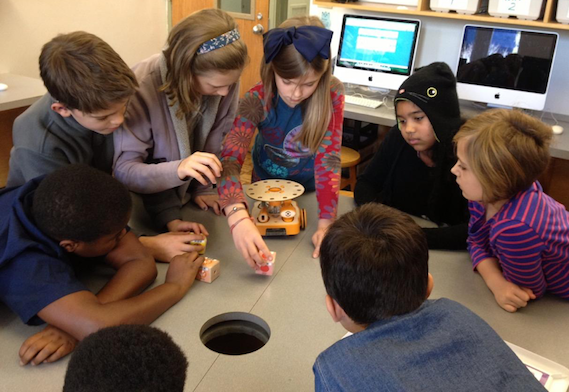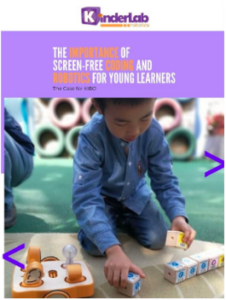Top Tips for Teaching AI in Early Childhood Education
What should young children know about AI applications? In last week’s post we talked about why it’s important to teach AI in early childhood education: just as with other aspects of STEM and CS literacy, starting early with AI helps build universal understanding of new tools and technologies.
But what do we want young children to know about AI applications?
 If one of STEM education’s goals is to help children understand their rapidly changing technological world, then what is most important for them to understand about AI? Organizations like the AAAI and CSTA have begun to develop useful and specific technical guidelines for teaching about AI, and these efforts will be valuable in developing future CS and AI curriculum in K-12. As supporters of empowering students with STEM education, we should step back and consider the big picture of what our youngest learners should know about AI applications.
If one of STEM education’s goals is to help children understand their rapidly changing technological world, then what is most important for them to understand about AI? Organizations like the AAAI and CSTA have begun to develop useful and specific technical guidelines for teaching about AI, and these efforts will be valuable in developing future CS and AI curriculum in K-12. As supporters of empowering students with STEM education, we should step back and consider the big picture of what our youngest learners should know about AI applications.
Here are four important ideas about AI applications that young kids should know:
#1 – AI is a tool made by people. Artificial intelligence can sometimes seem like “magic”. But it is just a tool invented and created by human engineers. It’s like other tools people have made — hammers, paintbrushes, bicycles, computers. People designed AI systems to work they way they did, and people continue to test and improve them. Understanding that AI is a tool helps demystify it and can make it seem less scary.
#2 – AI systems (and robots!) make decisions based on input and rules. When humans design AI systems and robots, one of the most important things they do is build ways for these systems to sense the world, and the rules they use to decide how to act on what they sense. Engineers describe this as the “sense – think – act” cycle. Humans build the systems’ inputs and sensors, they program or train the rules, and they decide what actions the robot or AI can take. An AI system’s rules can be very complicated, and the rules can even change over time, but they are still rules. Understanding the sense-think-act cycle, and the role of engineers in designing it, shows students how AI and robots interact with the world.

#3 – AI doesn’t think like people do, and it’s not alive. Although we use the words “artificial intelligence”, the intelligence of these systems is different from human intelligence. In fact, AI systems using the “sense – think – act” cycle don’t actually “think” the way we do at all. They use the rules humans programmed into them to process and analyze a lot of information very quickly. Engineers can even design AI systems to seem like they are alive and thinking (by speaking with us, for example), but these systems do not think and they are not alive. They can’t choose what to do, and they aren’t aware of themselves the way people are.
#4 – AI can help people solve difficult problems. Even though AI doesn’t really “think”, AI is still an amazing tool for helping people think. AI is able to process much more information that people can, much more quickly. AI systems can help climate scientists predict weather patterns over long periods of time by analyzing huge amounts of data about temperature, wind, sunlight, and more. AI can help doctors diagnose diseases by comparing information about many patients and many symptoms all at once. Understanding these abilities will help students understand how AI can be used responsibly; and it might even inspire them to work on developing AI themselves!
Discussing these “big picture” ideas about AI will help kids develop perspective on this technology. The impact of AI is certain to grow — in school, in work, in entertainment, and in politics. Many of us will use AI without an understanding of the basic principles that structure it. We owe it to our students to empower them with a clear view of this impactful new technology, so they can engage with it productively and with a sense of control.
What do you think about the relevance of AI in early childhood education? Have you started to teach about AI? We’d love to hear your stories and opinions. Let us know on social at @KinderLabRobot, or just email me directly at jason@kinderlabrobotics.com!
-Jason Innes
Director of Curriculum, Training, and Product Management
Meet KIBO, the Screen-free Educational STEAM Robot
KIBO, the learning robot designed specifically for elementary-aged kids, offers an inviting, engaging platform for young children to start their journey into creating with code in a fun and creative way. KIBO’s block-based coding language gives children control over the robot’s movements, sounds, and sensors, allowing them to express their imaginations with code. The KIBO curriculum for educators also teaches children to tell stories, create characters, and explore the world around them through code. KIBO is the number one choice in screen-free coding for kids – trusted by more parents and schools to introduce today’s youth to the wonders of technology and robotics.



















